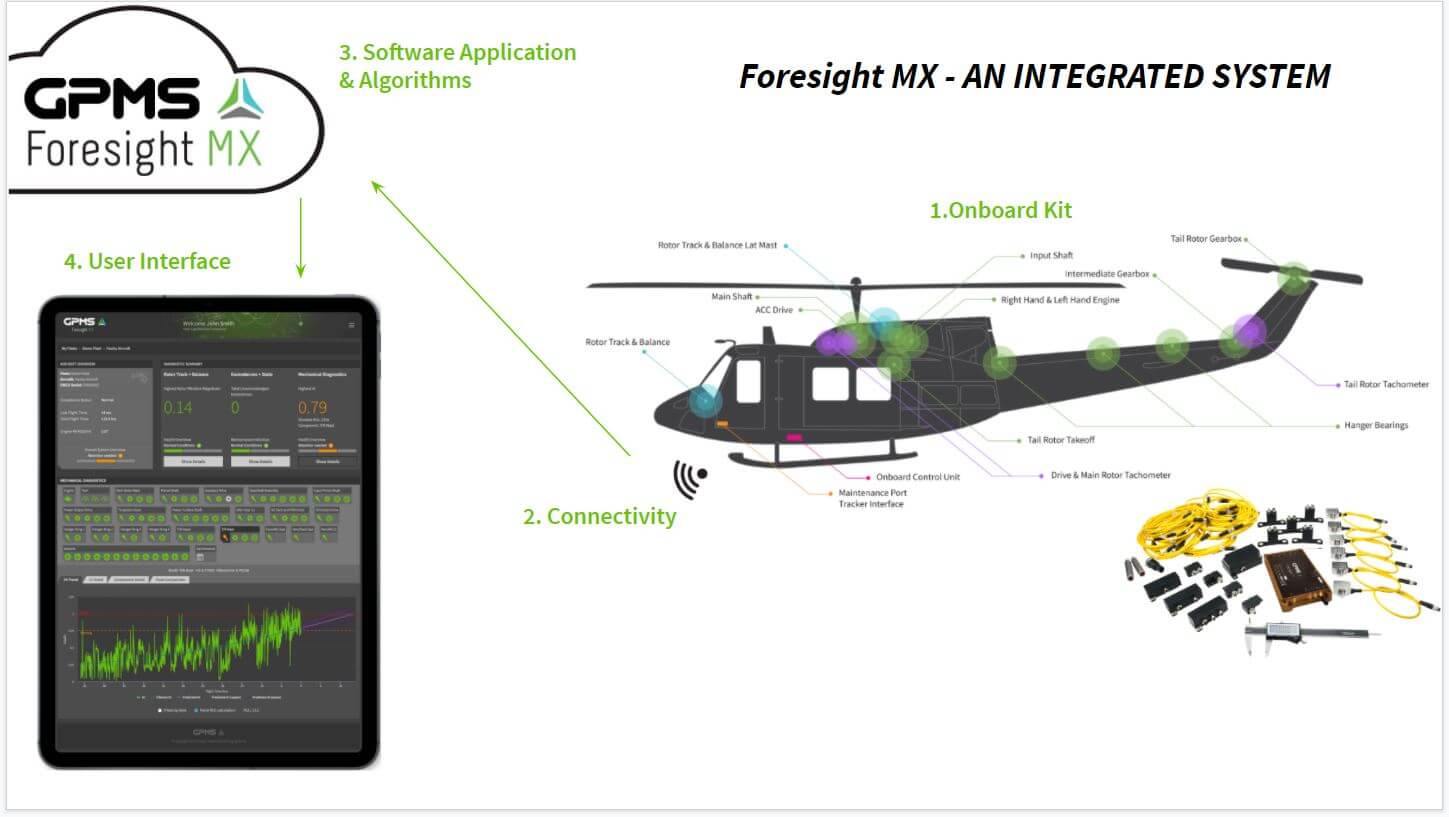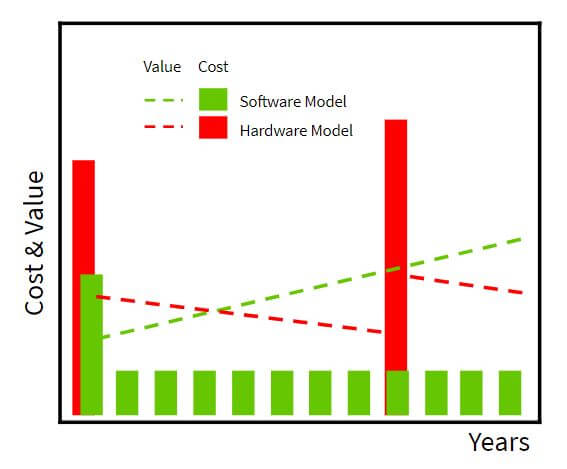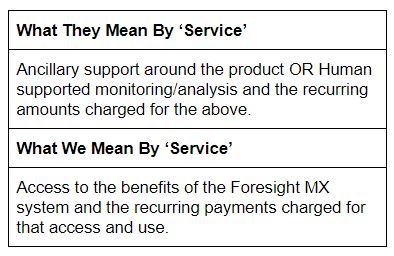HUMS-as-a-Service
By Jed Kalkstein, President GPMS
This month, GPMS was awarded an STC for its Foresight MX HUMS adapted for the AS350 AStar helicopter platform. As part of this product release we’re also going public with our pricing — an industry-first HUMS-as-a-Service model.
What does “HUMS-as-a-Service” mean? Fundamentally, it means that we’ll be offering Foresight MX on what in other industries has been called a Software-as-a-Service model together with an up-front startup fee that includes the onboard system, or “kit.”
Given that traditional players in this category have thought of HUMS as a hardware product and sold it as such, we wanted to spell out how our model differs and — more importantly — why this path works better for you, our customers, as well as us.
Traditional HUMS: The Kit is the Product
For legacy providers, HUMS was hardware. Vendors sold sensors, maybe bracketry, wire, and a central processing unit as a bundled, usually STC certified, kit. Once installed on the aircraft, that system gathered data in flight. Data was manually downloaded to a dedicated PC “ground station” where local analytical software typically resided. Onboard firmware and software was relatively fixed and very difficult to update. Similarly, the PC-based analysis software required digital handshakes, downloads and (frequently) priced upgrades to change.
Those relatively static and hardware-centric systems were sold on a hardware model: one time, upfront costs represented the bulk of the purchase price. This is not to say there was no service element. In many cases, these were hidden costs for third-party software or expert analysis, which often required recurring service fees for human-supported monitoring. In those instances, raw data would go from the operator to the consultant and then back in the form of reports and action items. The other hidden costs are in decreasing value over time – either because they were unsupported or because there was no provision for keeping the analysis fresh and incorporating learnings over time.
Foresight: A Software-Powered System
Foresight takes a systems level approach to a product that includes onboard hardware, connectivity, software algorithms, and a web-based dashboard / User Interface (UI). For this discussion, we emphasize three points:
– Our Hardware is a Means to an End
In a HUMS system, hardware is critically important to improve system accuracy and specificity, automate data capture and download, while minimizing cost and weight. So we’ve radically improved the design of the onboard system to include smart sensors (faster acquisitions for accuracy), a bused architecture (to reduce cost and wire weight), and high-resonance bracketry (to separate signal from noise), among other things. At the same time, these hardware innovations generate no insight on their own and are only a means to an end. They are about getting good data ingested in the larger system so that proprietary algorithms can convert it to operator insight.
– Software (and Updates and Feature Additions) are the Product’s Core
These algorithms, and the larger software stack that lives at the sensor, Onboard Control Unit (OBCU), and cloud layers of our application, are the core of the Foresight “system”. For it is software that brings the signals emanating from the sensors to life. To use a familiar analogy, our hardware is the PC whereas our software is the Operating System and the Applications that run on it. It’s software that fundamentally enables system improvement and expansion. See ‘The Foresight Advantage – Updatability and System Maturation’ blog post. There are over 3 million lines of code in Foresight, which is estimated continue to grow to 4 million by 2022.
– Monitoring & Analysis are Built into a Platform Designed for Self-Service
Lastly, we’ve built the Software and User Interface with an eye for usability and self service. When the aircraft lands, if anything is trending or if an exceedance has been registered we send an alert. In the application, the system uses a red, yellow, green stoplight system to signal what needs attention. The graphs and UI are geared for maintainers, not experts in signal processing (although there’s plenty of drill-down capability for those that want to get to that level). On our normalized HI scale, 0.75 translates to “time to schedule maintenance”, 1.0 is time to do maintenance. And if questions remain, email and phone support from GPMS are steps away. So, while we’re here to lend an extra layer of value, many operators don’t require that. The reality is that you get more value from our system if it’s easy to understand and we save money if we enable that and reduce your needs for support – that alignment is a win-win.

GPMS Foresight is an integrated system including algorithms, software, connectivity, and kit
Software-Based Products Need Service-Based Pricing Models
Having described our approach to system design, and the dynamic role software plays, you can start to see how fixed ‘product’ pricing might not make sense. Because software companies know they need to continually improve their application they use periodic payments to do it — either through an initial plus upgrades model or a “Software as a Service” model.
In our case, lets look at the additions and improvements we’ve developed for customers AFTER initial system launch. And note that all these were done with configuration updates (no hardware modifications): Hydraulic Pump monitoring; Oil cooler fan spline monitoring; Oil cooler fan balance; Swashplate analysis; Cycle counting; All aircraft comparison view; Alert log; Maintenance logs, and Onboard system firmware display. See Foresight Updatability and System Maturation post.
Our Solution – ‘HUMS-as-a-Service’
Given this need to innovate and improve, we’ve built our pricing around a recurring subscription or services fee that gives access to Foresight and all its benefits. Put another way, we’re charging principally for the use and value of the system, not the physical stuff you hold in your hand or see on the aircraft.
But, in contrast to pure software companies, getting the Foresight service started depends on an onboard system as well as installation support and training. To address these upfront costs, we’ve added an upfront component.
One way of thinking about this model is by comparing it to the alternatives. We see four options, ranging from pure up-front to pure recurring service. As the table below makes clear, our solution is a service-focused model with an up front component that we can bring down due to the anticipated recurring fees. Not unlike Verizon who is able to sell a new iPhone for less because you are buying cellular service, GPMS is able to bring down the cost of the kit because we know we’ll have service revenue going forward.

Financial Benefits: Lower Barriers, Better Timing, Smoother Payments
Financially, by moving from what could be an all-upfront model to a recurring model (with an upfront component) we achieve three things for our customers:
– Lowers Barriers to Adoption: By moving cost from up-front hardware to recurring service, we’re able to lower the up-front startup costs and make the product much more accessible to operators who want access to this tool but don’t have the multiple hundreds of thousands required under a pure hardware model.
– Syncs Expenditures and Revenues: By spreading costs out over time, we sync our invoices to actual operator cash flows. This again makes it easier for operators to afford Foresight and removes the need for financing.
– Smoother and More Predictable Payments: These recurring payments also reduce lumpy, less predictable payments, enabling operators to plan and budget based on known operating expenditures.
The True Benefit – An Aligned Customer-Supplier Relationship
But we think the real benefit of this model for operators has less to do with finances, and more to do with value. Because GPMS depends on customer renewals, the SaaS model provides a powerful Incentive for us to keep adding value. Put another way, it incents us to improve the product and provide exceptional support — we need to earn your business every day, not just at the outset.
As one operator told us, traditional HUMS players often “sold and scrammed” leaving operators unsupported with a “box” (their words) that degraded in value over time. In our model, GPMS depends on renewals so we need to constantly improve, and support our product and customers. We know that if you are no longer seeing the annual value, you will (and should) send us packing. We’ve talked about product expansions and improvements. Similarly, because GPMS depends on software renewals, we don’t see product support as a cost; we see it as an opportunity to solidify the relationship and ensure customers are satisfied. We’ve built a support pathway directly into the UI.

In Hardware model, product degrades over time requiring frequent and lumpy expenditures
Summing Up – Paying for Value, Not A Box
In the last 15 years, we’ve seen a dramatic shift in how companies operate. With Spotify and Netflix, we stopped buying physical products (CDs and DVDs) and started buying access. In our own industry, on the fixed wing side (and increasingly with helicopters) we’ve seen a move away from buying aircraft toward buying use in Power-by-the-Hour contracts.

We think the best companies innovate on both the product and business level, doing things differently and better in both areas. At GPMS, we’re determined not only to create a revolutionary HUMS system, but also to deliver it in a way that surprises and delights our customers. We think our pricing model is key to this effort. We invite you to discuss your needs with us. Get in touch at info@gpms-vt.com
